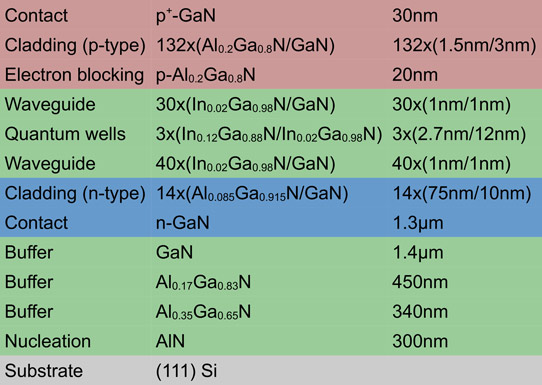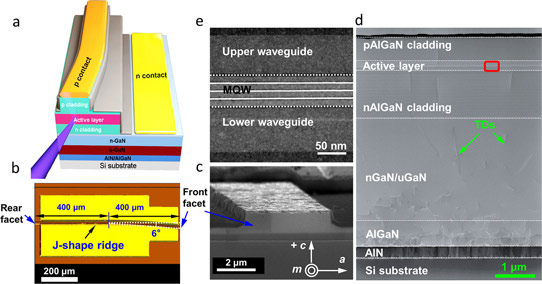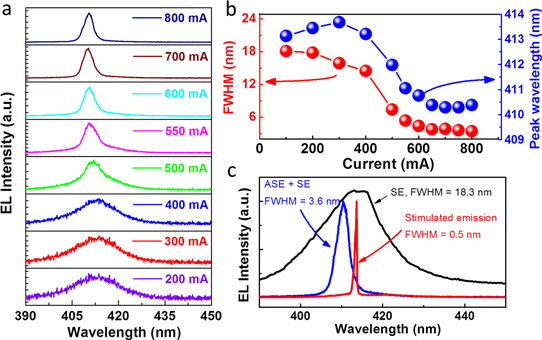- News
29 August 2019
III-nitride superluminescent diodes on silicon for displays and communication
Researchers in China have developed indium gallium nitride (InGaN) superluminescent diodes (SLDs) mononlithically integrated on silicon substrates [Jianxun Liu et al, ACS Photonics, published online 9 July 2019]. The team from Suzhou Institute of Nano-Tech and Nano-Bionics (SINANO), University of Science and Technology Beijing, and University of Science and Technology of China, sees opportunities for compact on-chip light sources for speckle-free displays and visible light communications (VLC).

Figure 1: III-nitride epitaxial structure of SLD, using combinations of aluminium indium gallium nitride (AlInGaN) alloys.
The researchers used metal-organic chemical vapor deposition (MOCVD) on (111) silicon substrates to create the III-nitride structure (Figure 1) for the SLD (Figure 2). The index-guided SLD featured a 4μm-wide ridge, which was J-shaped to suppress optical feedback oscillation in the 800μm-long cavity. Optical feedback runs the risk of laser action, which is not desired in SLDs. The J-bend of 6° occurred halfway down the cavity. The bend resulted in a facet that was not perpendicular to the cavity direction, allowing light to escape more easily.

Figure 2: (a) Three-dimensional illustration of InGaN-based SLDs grown on silicon with J-shaped ridge waveguide. (b) Top-view optical microscopy image of bar of InGaN-based SLDs after facet cleavage. (c) Scanning electron microscope image of cleavage facet. (d) Cross-sectional scanning transmission electron microscope (STEM) image. Total thickness of epitaxial layer was 5.8μm. (e) Enlarged STEM image of marked zone in (d).
The ridge waveguide and device mesa were formed with plasma etch. The p- and n-electrodes consisted, respectively, of palladium/platinum/gold and titanium/platinum/gold. After thinning, lapping and chemical mechanical planarization (CMP), the wafer was cleaved into bars containing 24 devices each. Comparison laser diodes were produced with straight waveguides. The devices were tested without packaging or facet coating.
The superluminescence of the device was demonstrated from the reduction in linewidth as the current injection increased from 400mA to 800mA, giving a reduction in full-width at half-maximum (FWHM) from 13.8nm (102meV) to 3.6nm (26meV), respectively (Figure 3). The main part of the reduction in FWHM occurred around 500mA when the value was 8.5nm (67meV), indicating the main onset of amplified spontaneous emission (ASE). In laser diodes, the reduction in FWHM is sharper, and generally results in linewidths narrower than 1nm – the fabricated comparison laser diodes had FWHMs of ~0.5nm (3.7meV) above threshold.

Figure 3: (a) EL spectra of SLD under various pulsed injection current at room temperature. (b) Peak wavelength and FWHM as function of injection current. (c) Comparison of EL spectra for SLD below threshold (100mA), above threshold (800mA), and stimulated emission from LD (250mA) with identical epitaxial design.
As the current through the SLD increased, there was at first a red-shift and then a blue-shift of the electroluminescence (EL) peak wavelength. The researchers comment: “The observed red-shift under a low injection current can be attributed to the bandgap narrowing resulting from many-body effects. While the blue-shift of the EL peak under a high injection current can be explained by combined effects of the band-filling effect and the carrier-induced screening of the quantum-confined Stark effect.” The quantum-confined Stark effect refers to the electric field that arises in III-nitride semiconductor heterostructures due to the charge-polarization of the chemical bonds. The effect tends to shift electron energy levels and to negatively impact electron-hole recombination into photons.
The transition from spontaneous emission to ASE was also reflected in optical polarization measurements. Even below threshold, the emissions were dominated by the transverse electric (TE) modes of the waveguide structure. The degree of polarization, as expressed by the difference in TE and transverse magnetic (TM) emission relative to the total emission, increased from 84% to 97.6% between 400mA and 600mA injection. The 97.6% value is said to correspond to 20dB polarization extinction ratio (I make it 19dB, but I may have worked from a different definition).
Comparing SLD and comparison laser diode threshold currents, the former occurred around 550mA, while the latter achieved lasing around 230mA, less than half the value of the SLD.
The SLD light output power began to saturate at 1100mA injection, and rolled off at 1400mA when about 2.5mW. Although the power was measured under pulsed injection, the saturation and roll-off was attributed to heating effects. “A significant improvement in optical output power is expected for the SLDs by applying anti-reflection coating to the cavity facets and adopting proper packaging with good heat dissipation,” the team writes.
Current-voltage and capacitance-voltage measurements were used to assess the resistance-capacitance (RC) bandwidth of the devices. The series resistance was estimated at 2.8Ω for the SLD, on the basis of the linear section of the current-voltage plot between 150mA and 400mA injection. A similar estimate for the laser diode gave 2.6Ω series resistance. A 1MHz modulated signal with the diode biased between -8V and +2V gave a capacitance estimate of 32.5pF at -4V bias, representing deep depletion in the diode (34.4pF for the laser diode). The RC time constant for the SLD was 90ps, representing a frequency of 1.77GHz. This opens up VLC opportunities.
InGaN superluminescent diodes InGaN SLDs MOCVD Silicon substrates
http://doi.org/10.1021/acsphotonics.9b00657
The author Mike Cooke is a freelance technology journalist who has worked in the semiconductor and advanced technology sectors since 1997.


